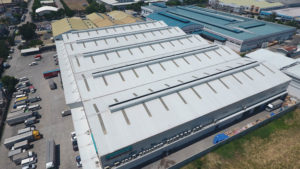Have you been feeling the heat lately? Yes, it’s almost intolerable. The fact that the Philippines is a tropical country doesn’t help at all. While our neighboring countries are having at least an offset of cool, breezy weather, the Philippines’ summer season is one which many of us aren’t really looking forward to. The advantage of enjoying a well deserved vacation during this time may sound tempting, but think about it, if you’re going to have your vacation within the country, you might as well spend it indoors, inside an air conditioned space with no means for the heat wave to enter. While there are some who can afford the luxury of owning an A/C unit, not many people actually have that same freedom. In such case, alternatives should be put in place; a cold drink, a ceiling fan, a well-insulated roof… Yes, you’ve read that right. Up until now, many of us do not realize the importance of having well-insulated roof panels. Understandably, this is because it is a fact only known by those who are much familiar with architecture and building components. The average person would take one look on their ceilings and think straightaway that all it ever conveys is a roof that keeps them safe and dry from the stormy weather, not realizing that it may also prevent heat from seething in during hot days. To further expound on this, here are a few pointers with regards to structural insulated panels and their features.
For starters, what are structural insulated panels or SIPs?
An online encyclopedia website defines SIPs as “a sandwiched structured composite, consisting of an insulating layer of rigid core sandwiched between two layers of structural board, used as a building material. The board can be sheet metal, plywood, cement, magnesium oxide board (MgO) or oriented strand board (OSB), and the core can be Polyurethane (PU).”
Now, do not be intimidated by the technical terms. Simply put, SIPs are building materials made up of two to three layers of other combined materials which functions as insulators. When we say insulator, we are referring to a surface which protects the space beneath it from the imposing heat of the sun. In such case, SIPs would be your roof, protecting your home from the sun rays. Now, you may ask, “Well, isn’t that the main function of a roof in the first place? To protect us from heat?” Yes, you are definitely correct, but that particular function is done by every other roof material you may find in your local hardware and construction material store. SIPs are specialized versions of these roof types, in the sense that they do a much better job of deflecting heat. It isn’t to say that they’d be able to turn your room into a frigidly cold space, but rather, significantly make it less hot than by using an average roof panel.
Okay, are structural insulated panels just limited to being roof materials?
No, they are not. As a matter of fact, they can also be used for many different applications, such as exterior walls, floors, and foundation systems. They are one of the most innovative construction components ever made, due to the fact that they extend their usefulness, not just for aesthetics or safety, but also for convenience. Especially for a tropical country such as the Philippines, construction materials which are manufactured with SIPs would definitely help ease up the day, with the heat being a huge hassle for everyone. The cases of heatstroke are rampant in the summer, mainly due to people not being able to find a solution for the glaring heat. The average electric fan can only do so much, as unprocessed hot air will remain to be hot air, and no matter how hard you’d adjust your fan settings, it would just blow and circulate all around your house, rendering it almost useless. The heat would be lessened when insulators are set in place, giving leeway for your fan to do its job in circulating warm air (warm, not hot).
Do SIPs exist in the Philippines? Or is it only a foreign construction material?
Fortunately, it can be found (and bought, if you are a construction personnel) here in our country as well. Union Galvasteel has their own line of SIPs in the market, albeit with a simplified name. Union Galvasteel’s Duratherm functions the same way as any SIP. It insulates heat from the sun, which reduces the amount of high temperature that enters your home. Again, it doesn’t necessarily mean that your home would be as cold as a refrigerator once it does its own “magic,” however, you’ll definitely feel the positive effects compared to when you just had a normal roofing material. Speaking of magic…
What is its secret? How does an SIP-manufactured material insulate heat?
To be honest, it could be more attributed to science rather than magic. We’ve mentioned before that structural insulated panels are “a sandwiched structured composite, consisting of an insulating layer of rigid core sandwiched between two layers of structural board, used as a building material.” In such case, one of those vital layers are foams. With that being said, Polyurethane (PU) is the most common of the foams used in this regard. With that measurement, you can just imagine how much of a huge help a whole span of roof panel can provide, especially during the summer. Imagine a durable material that both absorbs and deflects direct heat, preventing your indoor space from becoming a furnace.
Do I have more than one option when it comes to choosing an SIP?
Yes, you do. Union Galvasteel enables you to choose more than one when it comes to their lineup of structural insulated panels. You may either choose the Roofing PU Panel or the Standard PU Panel. Nonetheless, the product details are in their official website and you may check them out anytime: https://www.ugc.ph/productcategory/products/insulated-panel-duratherm/. You can also reach them via their contact numbers for more information: +639175033965; +639190032303.






